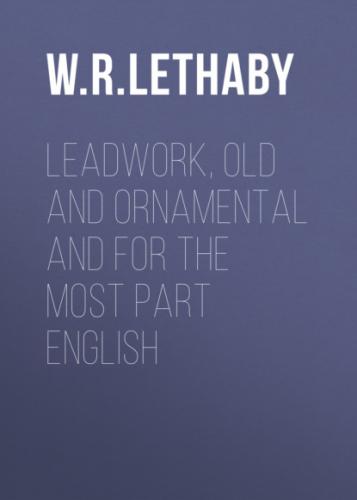The only way in which the crafts can again be made harmonious by beauty is for men with a sense of architectural fitness and a feeling for design to take up the actual workmanship and practise it themselves as they would painting or sculpture, seeking the delight of being good artists not the reputation of being successful merchants or clever professional men. To any such, lead-working may be recommended.
§ II. AN HISTORICAL SKETCH.
The ease with which lead ores may be gained from the earth and then worked, is sufficient to show that the application of lead to the service of the arts must have been made very early.
Nowhere does it seem to have been so easily found as “in England herself which is the classic land of lead and tin” (Abbé Cochet). These two metals made the early fame of Britain; they brought here the Phœnician trader and had doubtless much to do with the Roman occupation of this distant island.
“Tin and lead,” says Harrison in his Description of England, “metals which Strabo noteth in his time to be carried into Marseilles from hence, as Diodorus also confirmeth, are very plentiful with us, the one in Cornwall, Devonshire, and elsewhere in the north, the other in Derbyshire, Weredale, and sundry places of this island.... There were mines of lead sometimes also in Wales which endured so long till the people had consumed all their wood by melting of the same.”
Tin, which was of such sovereign necessity for the composition of bronze, was, with lead, an object of wide commerce, as we may learn from the prophecy of Ezekiel against Tyre, whose long black ships did the carrying trade of the world. As the Tarshish of Scripture is the Tartessus of classic authors—an entrepôt of Phœnician trade in Spain—it may well be of English mined metal that the prophet speaks:—“Tarshish was thy merchant by reason of the multitude of all kinds of riches; with silver, iron, tin, and lead they traded in thy fairs.”
The Assyrian slabs which contain the accounts of the expedition into Syria in the ninth century B.C. include among the tribute exacted of Tyre and of Jerusalem itself “bars of gold, silver, copper, and lead.” Solomon used lead in the structure of the great wall of Jerusalem.
Sir H. Layard says the mountains three or four days’ journey from Nineveh furnished iron, copper, lead, and silver in abundance, and he found instances of its actual use at Nineveh. Place also, in his excavations at Khorsabad, discovered a foundation inscription of Sargon II., the great builder of the eighth century B.C. engraved on a plate of lead. A leaden jar and a piece of pipe were found by Loftus at Mugheir.
In Egypt it was sparingly used. Sir G. Wilkinson says:—“Lead was comparatively useless, but was sometimes used for inlaying temple doors, coffers and furniture, small statuettes of the gods were occasionally made in this metal, especially those of Osiris and Anubis.”
In Egypt as well as in Babylonia it was the custom to make a deposit of several objects in the foundations, a tradition which we still follow to-day. At Daphnae Mr. Flinders Petrie found a set of little slabs of different stones and small plates of metal, gold, silver, copper, and lead, all engraved with the name of Psamtik. The lead tablet is here figured.
Fig. 1.
The ornamental objects of lead to which the earliest date can be assigned are those found by Dr. Schliemann in his excavations at Mycenæ and Tiryns.[1]
The Greeks very largely used lead for many purposes. It is twice mentioned in the Iliad, and its familiar use as a building material is shown by Herodotus, who says that Queen Nitocris built a bridge over the river at Babylon, of stone bound together with lead and iron; and the story the Greek historian gives of the celebrated hanging gardens describes how they were raised on high terraces of arches covered with bitumen and sheets of lead.
Sufficient actual examples of Greek lead work are stored up in museums, masonry with dowels of lead, inscribed tablets, small toys and tokens, little vases for eye salve about as large as a thimble, boxes for unguents, and sling bullets. These last are often inscribed so that the warrior might know his work, often with flouts and jibes and jeers. One in the Lewes Museum has ΕΥΓΕΙ,—“Well done”; others have “Hit Hard,” &c.
In the museums of Athens are some small figures, a Dionysiac wreath of gilt lead leaves to be worn as a garland, a lead quiver for arrows about fifteen inches long, also plummets and market weights, with other objects. Mr. Cockerell found that parts of the early pediment sculptures at Ægina were of lead, and lead is inlaid in the volute of the early Ionic capital from the archaic temple of Ephesus now in the British Museum.
Конец ознакомительного фрагмента.
Текст предоставлен ООО «ЛитРес».
Прочитайте эту книгу целиком, купив полную легальную версию на ЛитРес.
Безопасно оплатить книгу можно банковской картой Visa, MasterCard, Maestro, со счета мобильного телефона, с платежного терминала, в салоне МТС или Связной, через PayPal, WebMoney, Яндекс.Деньги, QIWI Кошелек, бонусными картами или другим удобным Вам способом.
